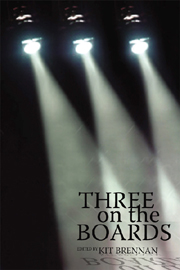Your cart is currently empty!
Important Shipping Notice: Due to the ongoing Canada Post strike, delivery times may be longer than usual. Where possible, we’ll use alternative shipping methods to help get your order to you sooner. We appreciate your patience and understanding as your order makes its way to you.
A note to US-based customers: All Lit Up is pausing print orders to the USA until further notice. Read more
Three on the Boards
Included are: Curtsy by Brian Drader, In the Yichud Room by Joel Fishbane, Suicide Notes by Kenneth T. Williams, Canada House by J. Karol Korczynski, Starter Home by Katherine Koller, Three Dogs Barking by Frank Barry, and Purity Test by Scott Sharplin. In plays for three actors, everyone is fighting their own battle in a sharp-cornered ring, which flings them together and then apart. These seven plays from writers across the country paint a dark and mainly urban picture of Canada in the first decade of this new millennium. Love is variously celebrated and thrown away; as is tolerance, as is hope. Many of the characters are running as hard as they can away from themselves. At the same time, they are endearing, caustic, funny, and very human.
Details
Dimensions:
312 Pages
9in * 6.03in * .75in
480gr
Published:
October 20, 2007
Publisher:
ISBN:
9781897109199
Book Subjects:
Featured In:
Language:
eng
No author posts found.
